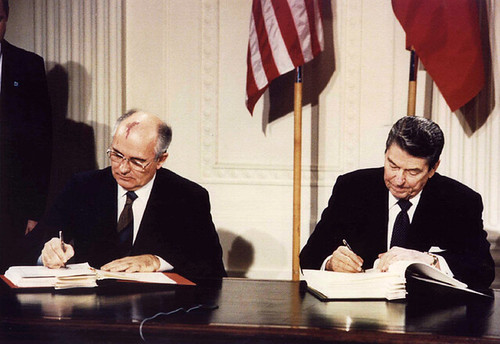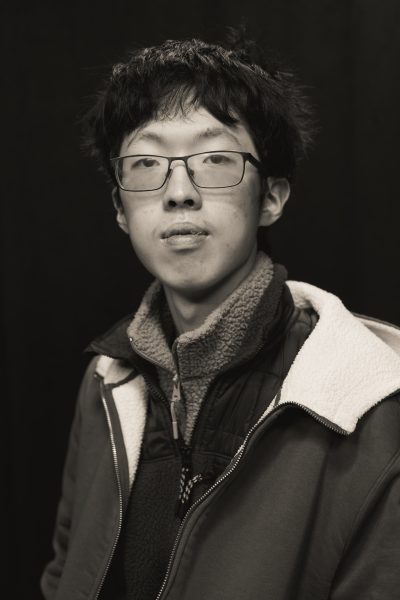The Legacy of Mikhail Gorbachev
The former Soviet leader ushered his country into the modern era, but in his homeland, his memory is conflicted.

“Gorbachev & Reagan signing treaty 8 Dec 1987” by jimforest is licensed under CC BY-NC-ND 2.0.
Mikhail Gorbachev, once one of the most influential figures in global politics, was awarded the Nobel Peace Prize (1990) in recognition of his role in de-esclalating the Cold War.
September 19, 2022
On August 30th, 2022, Mikhail Gorbachev–the final leader of the Soviet Union–passed away. His role on the international stage left an enormous impact on both the politics and people of the world. But as Russian politics have changed course since his westernized ideals, the late leader’s legacy has grown disputed.
Gorbachev was born on March 2, 1931, in Privolnoye, USSR (now Russia). His early years as a child and teenager were grim, “growing up amid the horrors of Nazi Germany’s invasion of the Soviet Union,” and the brutal regime of former leader, Joseph Stalin. But despite these rough beginnings, Gorbachev quickly got to work rising up the ranks.
By 1952, Gorbachev became a member of the Communist Party and graduated from Moscow State University by 1955. From then on, his status and recognition would continue to increase, becoming a candidate member of the Politburo in 1979 and a full member in 1980. With the death of General Secretary (or leader) Konstantin Chernenko in 1985, Gorbachev was elected by the Communist Party to succeed him.
Gorbachev’s time as leader of the USSR led to some of the most dramatic reforms and changes–not just domestically, but internationally as well. After a failed attempt at rapid modernization, in 1987 to 1988 Gorbachev introduced two revolutionary policies for political and economic reform–glasnost and perestroika.
Ever since the beginning of the Communist Party in Russia, the USSR–thanks to the foundations established by its first leader, Vladimir Lenin, and further amplification of such foundations by Stalin–harbored a reputation as a brutal, authoritarian regime. But when Gorbachev introduced glasnost, the country’s reputation quickly began to reverse.
Glasnost allowed for both criticism of government officials and provided the media with freer dissemination of news and information, leading to a major cultural thaw in Russia. At the time of implementation, these newly-granted freedoms were groundbreaking for Soviet citizens.
Additionally, Gorbachev also planned out a restructuring of Soviet politics and the country’s economic system. This was called perestroika. Despite being met with heavy resistance by other Communist Party officials, for the first time in its history, the Soviet Union would allow for both multi-party elections and even the integration of a few limited free-market mechanisms into the economy.
The effects of Gorbachev’s radical reforms quickly spread beyond the national level. In March of 1985, before perestroika could begin, Gorbachev needed to reduce military spending at home and political tensions abroad. In order to accomplish such a task, relationships with the Soviet Union’s biggest rival–the United States–had to improve.
In November of 1985, Gorbachev met with US President Ronald Reagan for the first time in Geneva, Switzerland, aiming to ease the tensions between the two superpowers. This decision would pay off tremendously, with the several following meetings ultimately leading to the signing of the 1987 Intermediate Range Nuclear Forces (INF) Treaty, eliminating 2692 short, medium, and intermediate-range missiles by the treaty’s implementation deadline of June 1, 1991.
With pressure being alleviated from US-Soviet relations, Gorbachev sought to end another foreign crisis initiated by former leader, Leonid Brezhnev of Afghanistan. Between 1987 and 1988, Gorbachev would call for the withdrawal of Soviet troops, ending their nine year occupation of the country. However, the most significant moments of his leadership (and future legacy) would come in late 1989, when he turned his attention to the eastern bloc of Europe.
Following the Allies’ victories in WWII, all territories taken by the Red Army were occupied by the USSR. These included East Germany, Poland, Hungary, Czechoslovakia, and many others. At the time they were conquered, Stalin made certain that these countries would follow a Soviet-style government. Even after the dictator’s death in 1953, future leaders would continue their brutal suppression of any reform in the eastern bloc.
But by 1989, Gorbachev was starting to tear down the walls–both metaphorically and literally. One by one, with Gorbachev’s approval, the European countries of the eastern bloc began toppling their Soviet-style puppet governments through free, democratic elections. Most notably of all was the fall of the Berlin Wall, a monumental moment that paved the way for the reunification of Germany.
As the years went on, Gorbachev would further expand his policies of glasnost and perestroika at home, causing a slow, but noticeable democratization of the USSR. Free, multi-candidate elections were becoming more and more prominent, and Gorbachev made many attempts to loosen the strict, one-party system. Unfortunately, the new array of freedoms and open environment also happened to be loosening Gorbachev’s power.
In March of 1991, inspired by the reforms in the eastern bloc, the Baltic states (Estonia, Lithuania, and Latvia), after years of remaining under the domination of the USSR, finally declared their independence from the greater Soviet Union.
By August 18th, many hardliners of the Communist Party, enraged by both the secession and the recent reforms, placed Gorbachev under house arrest and attempted to set up their own government. Ultimately, however, the coup failed when Boris Yeltsin–leader of the Russian Parliament–and his supporters rallied outside the parliament building with a tank.
However, even after being freed, Gorbachev’s reign would not last much longer. Yeltsin had long been leading a radical democratic movement over the conservative Soviet government, with ambitions of creating a sovereign Russian Federation. His image and popularity would only grow after saving Gorbachev from the failed coup.
On December 8th, 1991, Yeltsin signed an agreement with the leaders of both Ukraine and Belarus; the Commonwealth of Independent States was created to kickstart the dissolution of the Soviet Union. Having lost control of the KGB, parliament and even his own presidential office to Yeltsin, Gorbachev was forced to resign seventeen days later; the Soviet Union went down with him.
Gorbachev’s legacy has left mixed perceptions across the world ever since the dissolution of the USSR. For much of the Western world, he was the hero who assisted in ending the Cold War, the peacemaker who eased nuclear tensions, and a fighter for liberal reform and democratization. This was made especially apparent when he was awarded the Nobel Peace Prize in 1990.
On the other hand, in the wake of his death, a deep division surrounding Gorbachev’s legacy has revealed itself in Russia. While some view the former leader in a similar light as the Western world, others blame him for the fall of the USSR, seeing it as a great humiliation.
What remains beyond dispute, however, is that Mikhail Gorbachev was one of the most influential figures of the 20th century. Despite the conflicting opinions surrounding his policies, there is no doubt that his legacy marked a major turning point in history and paved the way for the political, economical, and social climates of the modern world.











